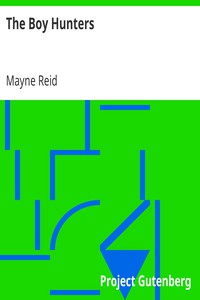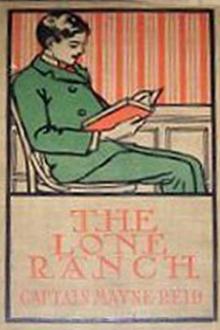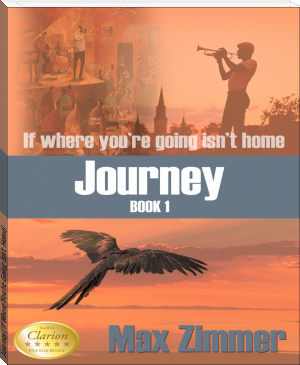The Boy Hunters, Mayne Reid [best love novels of all time .TXT] 📗

- Author: Mayne Reid
Book online «The Boy Hunters, Mayne Reid [best love novels of all time .TXT] 📗». Author Mayne Reid
Lucien was in raptures with the interesting lesson he was receiving; and again restrained François from rushing forward. They all, however, crept a little nearer—so as the better to observe the further movements of the serpent. They kept as well as possible behind the screen of leaves and bushes.
The snake, after having killed the lizard, remained out in the open ground; and, stretching himself along the grass, commenced devouring it. Snakes do not masticate their food. Their teeth are not formed for this, but only for seizing and killing. The blood-snake is not venomous, and is, therefore, without fangs such as venomous snakes possess. In lieu of these he possesses a double row of sharp teeth; and, like the “black snake,” the “whip,” and others of the genus coluber, he is extremely swift, and possesses certain powers of constriction, which are mostly wanting in serpents of the venomous tribes. Like all the others, he swallows his prey just as he kills it—whole. So with the one in question. Having placed the nose of the lizard vis-à-vis with his own, he opened his jaws to their full extent, took in the head, and commenced gradually sucking the body down his throat. It was a curious operation; and the boys watched it with feelings of interest.
But other eyes were bent upon the reptile. His bright blood-coloured body lying along the grass had caught the far-seeing eye of an enemy, whose dark shadow was now seen moving over the ground. On looking up, the boys beheld a large bird wheeling in the air. Its snow-white head and breast, the far spread, tapering wings, but, above all, the long forked tail, told them at a glance what bird it was. It was the great Southern kite (Falco furcatus).
When first seen he was sailing in circles,—or rather in a spiral curve, that was constantly contracting downward and inward. The centre of that curve was the spot occupied by the snake.
It was a beautiful sight to behold this creature cutting the thin air. His flight was the beau idéal of ease and gracefulness—for in this no bird can equal the kite. Not a stroke of his long pointed wings betrayed that he needed their assistance; and he seemed to glory that he could navigate the air without them. Besides, the motion of these, had he used them, might have caught the eye of his intended victim, and warned it of the danger. I say it was a beautiful sight to watch him as he swam through his aery circles, at one moment appearing all white—as his breast was turned to the spectators—the next moment his black back and purple wings glittering in the sun, as sideways he guided himself down the spiral curve. It was a beautiful sight, and the young hunters stood gazing with silent admiration.
Basil and François wondered that he did not at once pounce upon the snake, for towards it his flight was evidently tending. They had seen other hawks do this—such as the red-tailed, the peregrine, and the osprey—which last sometimes shoots several hundred feet perpendicularly down upon its prey. Lucien, however, knew better. He knew that that feat can be performed only by those hawks whose tails are full and not forked, as the bald eagle, and the species already named—their spreading tails giving them the power to suddenly arrest the downward motion, and prevent them from dashing themselves against the earth. The kites, on the other hand, have not that power; and in this arrangement Lucien could perceive a beautiful adaptation of Nature—an equalising of advantages between these two kinds of birds. He reasoned thus:—
The hawks, although swift of wing, and capable of extended flight, cannot remain long in the air. They grow weary and need rest, which they take, perching themselves upon some tree. It may be observed, moreover, that they choose dead trees that overlook an open space. They do so, in order that the leaves may not obstruct their vision—thus giving them a wider range, and, consequently, a better chance of espying their prey. But even with this advantage their chances of seeing their prey are circumscribed, when compared with that of hawks upon the wing; and they are frequently compelled to take to the air in order to discover it.
Now the kites are always in the air, or nearly so. They, in fact, live upon the wing, eating their food as they fly, from their claws. Living thus, they have many more chances of seeing their prey than their cousins of the hawk species; and were they possessed of the power to pounce upon it with as much certainty as the latter do, it is evident they would have greatly the advantage. The want of that capability, however, brings them upon an equality; and, as I have said, Lucien perceived in this that peculiar equilibrium, or “balance of power,” which constantly presents itself to the student of Nature.
These thoughts passed through his mind at the moment. They occupied but a moment however—for it was but a few seconds from the time the kite was first noticed wheeling high in the air, until he swept along the tops of the low trees, so close that the boys could distinguish the red iris of his glistening eyes.
Now, for the first time, the snake caught sight of him. Hitherto it had been too much occupied with its own prey, which it had succeeded in swallowing. The shadow of the broad wings fell upon the sunlit sward directly before its eyes. It looked up, and saw its terrible enemy. It seemed to shiver through its whole length, and turn paler in colour. It struck its head into the grass, endeavouring to hide itself. It was too late. The kite swooped gently downward; and, with open claw, poised himself a moment over the spot. As he rose again, the reptile was seen wriggling in his talons!
A few strokes of his bold wing carried the kite upward, above the tops of the tallest trees; but he was observed to fly heavily. As he rose higher, the flapping of his wings became more hurried and irregular. It was evident that something was impeding his flight. The snake was no longer hanging from his talons. The reptile had twined itself around his body; and its glistening folds, like red bands, could be seen half-buried in the white plumage of the bird!
All at once the kite began to flutter—then one of his wings disappeared; and, notwithstanding the hurried flapping of the other, both bird and serpent fell heavily to the earth!
They fell close to the spot from whence they had risen. Neither was killed by the fall, nor, to all appearance, hurt; for, the moment after they had touched the ground, both were seen engaged in a violent struggle—the bird evidently endeavouring to free himself from the folds of the reptile, while the latter seemed equally bent upon holding him! The snake knew well that this was its only hope; for, should it unfold itself and endeavour to escape, it would only give the kite an opportunity of clutching it a second time, when he would be certain to do it with more fatal effect. It was because the reptile had buried its head in the grass that the kite had failed in seizing it properly by the neck, and putting an end to it at once.
This, no doubt, was the idea of the snake; but it is probable that its antagonist at the moment would have been delighted to “cry quits” with it, for the bird was in a worse “fix” than it was. As things stood, the serpent had undoubtedly the advantage.
It was likely to prove a protracted struggle; for, although there was much twisting and wriggling over the ground, and flapping of the odd wing—that was still free—very little change for a long time appeared to take place in the relative position of the combatants. This could be seen, whenever they paused to rest themselves—which they did every two or three minutes.
How was it to end? The kite could not kill the snake, for he could not get at it, either with his beak or talons. The hold which he had at first taken he had lost, in his attempts to save himself from falling; and he was now unable to renew it, so closely was the reptile warped around him. The snake, on the other hand, could not kill the kite; for, although possessed of considerable powers of constriction, they were not sufficient. It was strong enough to hold, and, perhaps, squeeze its antagonist, but not strong enough to crush and kill him.
Though each, no doubt, at the moment wished to be far enough from the other, they could not separate with safety to both. The kite could not get away, and the snake dared not let him go!
How, then, was the affair to end, in the event that no third party should interfere? This was the conjecture of our adventurers, as with curious eyes they watched this singular contest. The train of reasoning was as follows:—
By one or the other dying of hunger. But which would starve first? It was well-known that the kite could live for days without food. Ha! but so too could the snake,—nay, more, for every day the bird could go without eating, the reptile could fast ten; besides, the snake had just dined—dined sumptuously upon the scorpion-lizard, that was now lying undigested in his stomach; whereas the kite had not tasted dinner,—nay, it was very certain he had not breakfasted either—and must have been very hungry indeed to have attempted preying upon a blood-snake full four feet long—for, as is well-known, his usual prey is the locust, the chameleon, and the little green snake (Coluber aestivus). Under every view of the question then, the snake had the advantage of the bird, and would easily outstarve him. Thus, then, the affair would end, if the combatants were left to themselves.
The young hunters arrived at this conclusion; and, having watched the contest until their curiosity was satisfied, were about stepping forward to put an end to it, when a new manoeuvre on the part of the combatants caused them to remain still. The kite had got his beak close to the head of the serpent, and was striking with open mandibles, endeavouring to seize the jaw of the latter. He was upon his back—for these birds fight best in that position. The serpent, on the other hand, was trying his best to bite the bird; and for this purpose at intervals extended its jaws, showing the double rows of sharp conical teeth. At one of these intervals, while its mouth was open, the kite struck quickly upward, and seized the lower jaw of the reptile in his beak. The latter closed its mouth on the instant; but the horny mandible was impervious to its sharp teeth, and the bird regarded them not.
The kite continued to hold fast with his powerful beak. He had now gained the advantage, for which he had been all the while contending. He had got a “fulcrum for his lever,” and he was not slow in using it. Suddenly turning back upward, with the aid of his wing and one of his claws, he held himself fast to the ground, while with his strong neck he drew the head of the serpent close under him until it lay within reach of his other claw. Then with a quick fierce stroke he planted his talons,





Comments (0)